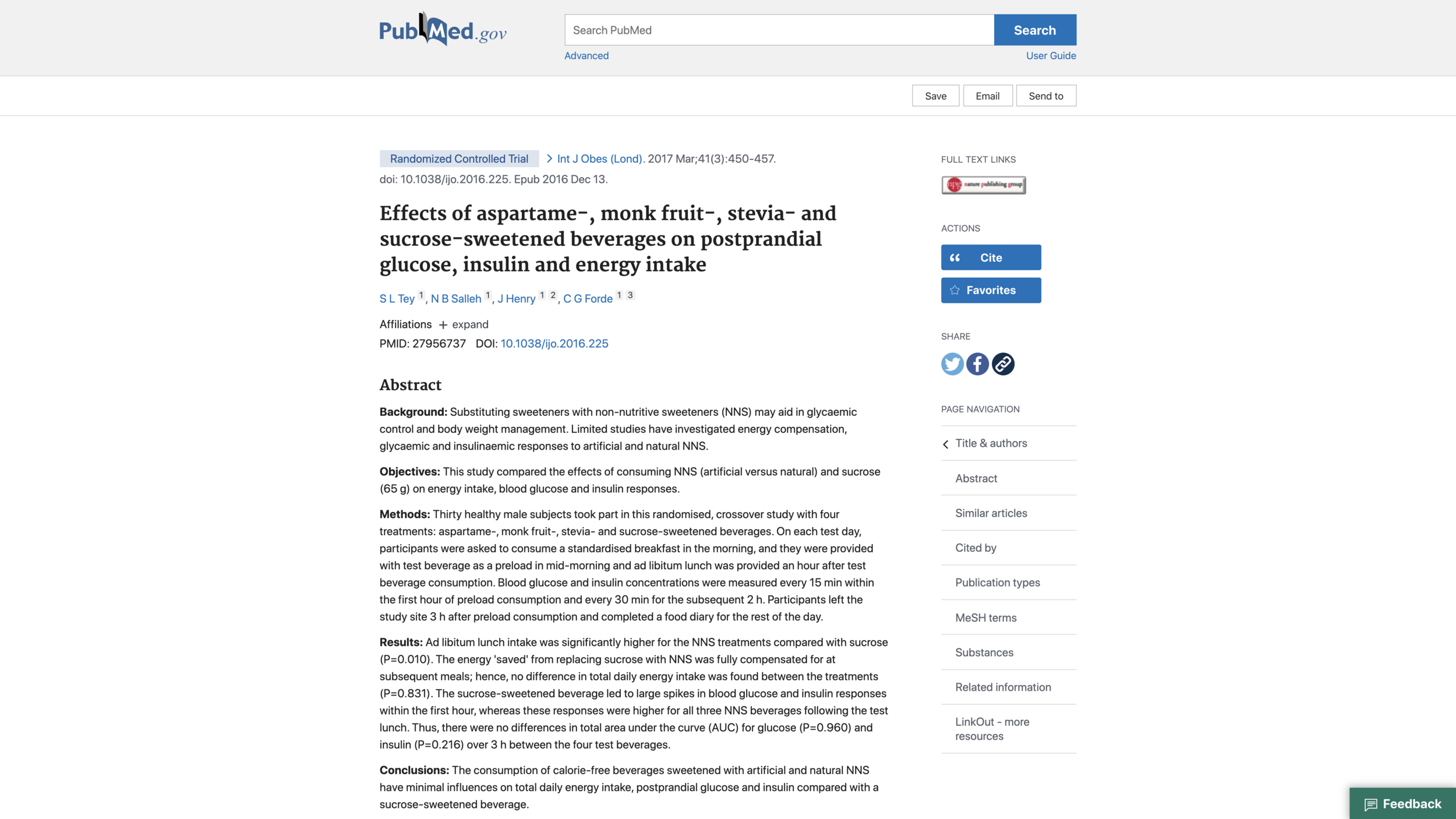Don't Drink Sweet Drinks Between Meals—Whether Sugary or with Nonsugar Sweeteners
For the bottom line of this post, you may want to jump to the Conclusion. Everything else is about backing up that advice.
Existing research doesn’t tell us as much about the effects of nonsugar sweeteners as one would like. But “Effects of aspartame-, monk fruit-, stevia- and sucrose-sweetened beverages on postprandial glucose, insulin and energy intake” by S L Tey, N B Salleh, J Henry, and C G Forde gives some hint that using nonsugar sweeteners as part of a substantial meal or snack is better than using nonsugar sweeteners in a zero-calorie beverage consumed as a snack on its own.
To be more precise, consuming a beverage on its own with a nonsugar sweetener seems to lead to people eating enough more that it doesn’t reduce overall calorie intake, blood glucose levels or blood insulin levels overall below what would happen if one consumed a sugary beverage. By contrast, using a nonsugar sweetener instead of sugar as part of a substantial snack seems to help in reducing overall calorie intake.
The introduction to the paper shown above reports on an experiment in which nonsugar sweeteners were part of a substantial snack:
To date, only one study has investigated the effects of artificial and natural NNS on food intake, postprandial glucose and insulin. This randomised crossover study utilised a double preload design to compare the effects of consuming two preloads of crackers and cream cheese sweetened with sucrose (986 kcal), aspartame (580 kcal) or stevia (580 kcal); one before lunch and one before dinner, on energy intake, postprandial glucose and insulin concentrations. Daily energy intake was significantly lower when participants consumed preloads with aspartame and stevia, compared with a sucrose preload. stevia preload also showed additional benefit of lowering postprandial blood glucose and insulin concentrations, compared with aspartame and sucrose preloads. However, it is unknown whether the beneficial effect of stevia can be generalised to monk fruit and also whether the same result can be obtained if the preload contains no calories, for example, diet beverage.
The conclusion of the paper shown above contrasts the results from a nonsugar sweetener instead of sugar as part of a substantial snack and the results from a nonsugar sweetener instead of sugar as part of a standalone beverage snack. As part of a standalone beverage snack, the zero-calorie beverage with a nonsugar sweetener left calorie intake, overall glucose level and overall insulin level in the same ballpark as an otherwise similar sugar-sweetened beverage:
… when participants consumed a preload of crackers with cream cheese sweetened with NNS, 20 min before lunch, postprandial glucose concentration following lunch was significantly lower with NNS compared with a preload sweetened with sucrose. Overall, the evidence seems to suggest that consuming NNS alone without any energy (empty calorie) before a meal may lead to larger spikes in glucose and insulin responses after the meal. The preload used in the current study resembles a pre-meal beverage such as a mid-morning sugar-sweetened beverage before lunch or a midafternoon soft drink before dinner
Conclusion: My advice is to not use sugar at all (see “Sugar as a Slow Poison” and “Letting Go of Sugar”) and only use nonsugar sweeteners as part of a meal or a substantial snack. Note also that juice counts as a sugar-sweetened drink—something to be avoided entirely. (Juice is much worse than whole fruit. See “Forget Calorie Counting; It's the Insulin Index, Stupid.”)
On the question of which nonsugar sweeteners to choose as part of a meal or substantial snack, see “Which Nonsugar Sweeteners are OK? An Insulin-Index Perspective.”
What to Drink Instead: Avoiding sweet drinks between meals doesn’t mean you have to drink plain water. Unsweetened coffee and tea (or perhaps minimally sweetened coffee or tea) do not have the problem sweet drinks have. Carbonated water, as from SodaStream or one of its competitors is great. And there is now a huge variety of flavored sparkling water. On that, see my post “In Praise of Flavored Sparkling Water” where I mention some of my favorites. (New varieties keep appearing so I may need to write another review of flavored sparkling water sometime.)
For annotated links to other posts on diet and health, see:
